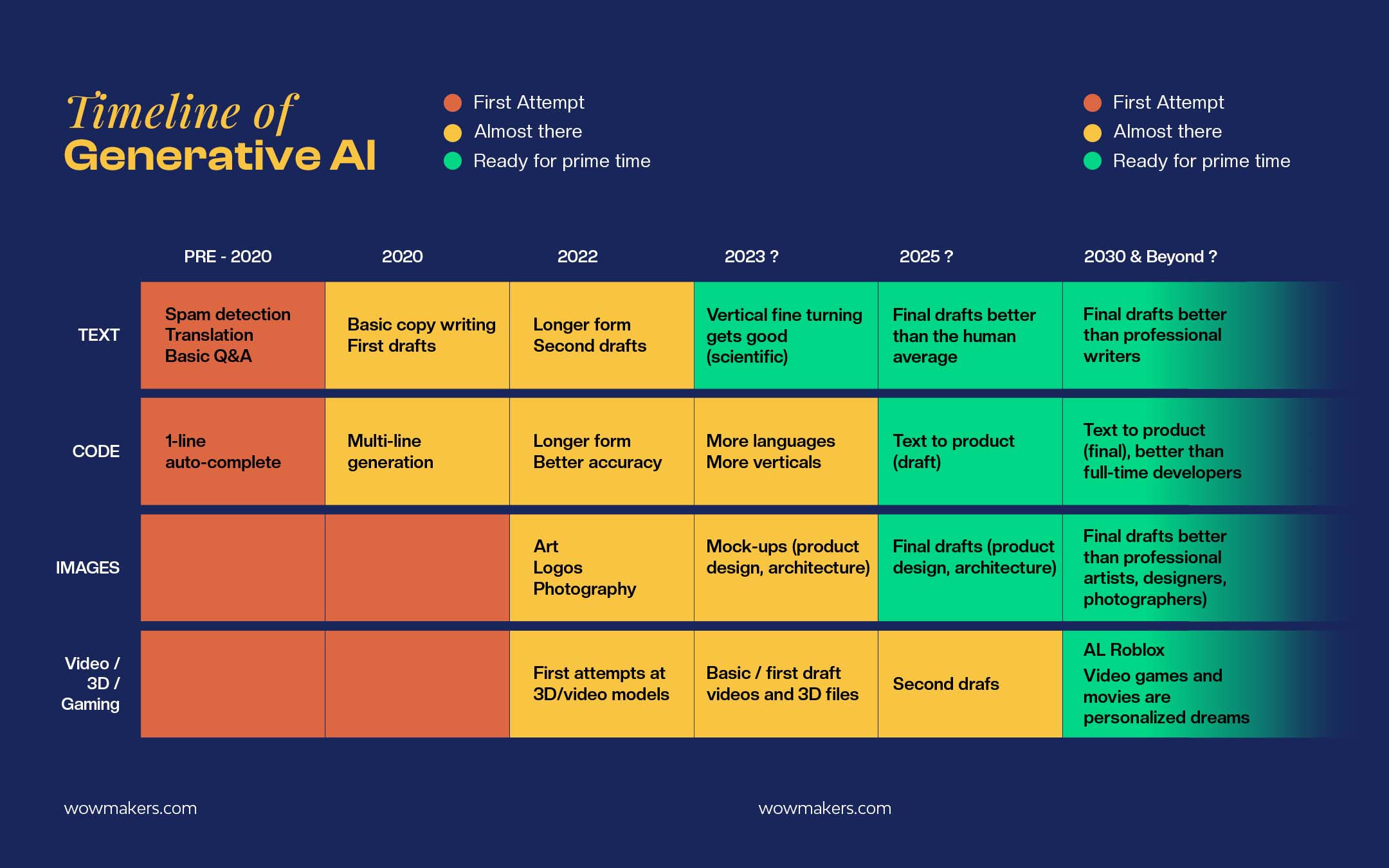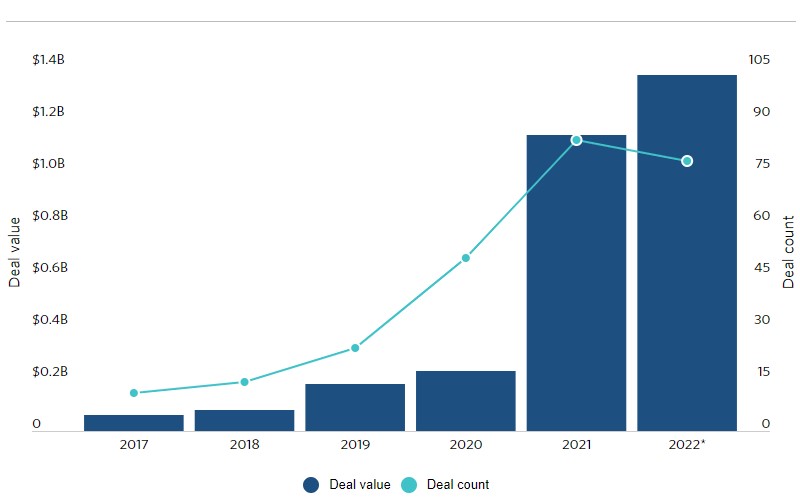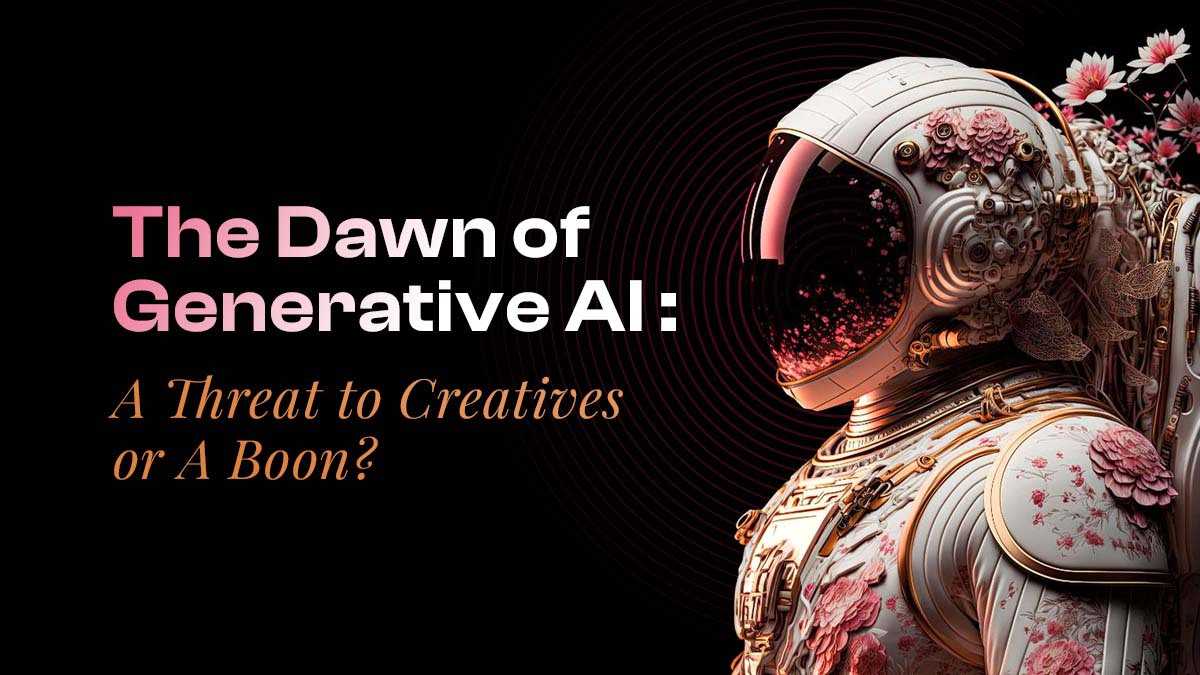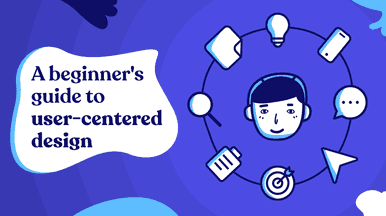Days to come are of Generative AI. It was the hottest topic in 2022 and will be the same in 2023, even though the technology is ground-breaking. There are a lot of myths, misconceptions, and fear lurking around. Will Generative AI replace the creativity of humans? Or will it steal jobs and artwork? We are addressing all that through this article.
Important note*: The artwork featured in this article has been created using Midjounrey’s generative AI art-making tool.

For us, AI is the Wingman in Creating better UX
Talk to Us
Traditional AI: The Past
Humans are skilled at analyzing things. Machines are even better. Machines can evaluate data and identify patterns for various use cases, such as fraud or spam detection, estimate your delivery’s ETA, and even determine which TikTok video to play next.
They are becoming more intelligent at these tasks. This is called “Analytical AI” or traditional artificial intelligence. But this side of AI is just the tip of the iceberg! Things are getting even more interesting from here on. What these tools can do shortly is magical.

What is Generative Artificial Intelligence?
Generative AI (artificial intelligence) is a revolutionary technology that can generate new and never-before-seen objects or effects through artificial intelligence. This type of AI uses powerful algorithms to learn from and develop data, enabling it to create new and unique results. Instead of relying on programming instructions for its output, generative AI can independently use its reasoning and decision-making capabilities to form conclusions and outputs.

Its ability to produce new content more efficiently than manual coding makes it an invaluable asset for businesses seeking improved customer engagement capabilities. The possibilities of this technology are virtually limitless!
Generative AI: The Present and Future

We are not just adept at understanding things but also at creating them. Until recently, software and computers could not compete with humans for creative work; they were limited to analysis and repetitive cognitive activity. However, machines are just beginning to be capable of generating pleasant and attractive things. This new category is termed “Generative AI,” implying that the machine generates something new instead of evaluating something already existing.
This blog post will explore generative AI, uncover some of its ethical implications and current applications, and shed light on what lies ahead for the pioneering technology.


Words speak little when you can see for yourself.
Check Our Portfolio
Timeline Of generative AI

Different Types of Generative AI
-
Image Generation
Generative AI models can create completely new images from scratch using only a few input parameters. This technology can be used for digital art and photo manipulation, creating realistic or surreal images that would otherwise take considerable time and effort to produce. The open-source tools DALL-E, Stable Diffusion, Midjourney, and Lexica are making it simpler than ever for enterprises to take advantage of this technology.
-
Image-to-Image Translation
Generative AI can be used to transfer the style of one image onto another. One image’s basic shapes and colors will be transferred to another.
-
Text-to-Image Translation
Generative AI can also be used to generate images from text descriptions. This allows users to create custom scenarios and visualize them in ways never before possible. It is perfect for vividly visualizing stories, concept art, and product design ideas. Open-source tools such as Open AI’s DALL-E, Stable Diffusion, Midjourney, and Lexica are making it easier than ever for businesses to take advantage of this technology.
-
Text-to-Speech
Generative AI can also turn written sentences into spoken words with lifelike accuracy and intonation. Many businesses today that provide services like automated customer service agents or interactive voice response (IVR) systems for call centers use this technology.
-
Audio Generation
Generative AI models can generate audio samples ranging from natural sounds to music and speech. For example, generative models have created atmospheric soundtracks that react dynamically based on user interactions within video games or virtual reality simulations.
-
Video Generation
Using generative AI models, it is possible to generate videos from scratch with no additional inputs besides a few labels describing what should appear in the video clip (e.g., “a person walking” or “a car driving down a road”). This technology is applied in animation, film production, advertising, etc., allowing artists more control over their projects while saving time and money.
-
Image/Video Resolution Enhancement
With the noise reduction techniques recently developed by researchers, generative AI models can increase the resolution of an image or video beyond its original quality with minimal loss of detail.
-
Synthetic Data Generation
The AI models have been deployed in areas where there is insufficient data to effectively train traditional machine learning models, such as medical research or autonomous vehicle development programs, which require large datasets for simulation purposes, but collecting real-world data may not always be feasible due to ethical considerations or financial constraints—generative models provide an effective workaround by generating synthetic data that is equipped with real-world data.
Generative AI news from around the globe.
- Picsart, has added personalization features to its digital production platform, unveiled last month alongside AI-powered writing and image generation services. Picsart’s AI Background and Replace functions take the generative AI tools beyond the initial production and into the editing phase, allowing users to replace items and create backdrops.
- USCO (United States Copyright Office) revoked the protection granted to the AI-generated image for the comic Zarya of the Dawn in September, stating that the copyright was issued initially before it was discovered that Midjourney was responsible for the comic’s artwork.
- It is anticipated that OpenAI’s ChatGPT will advance due to the company’s efforts to make the tool more conversational. The new ChatGPT allows users to give the tool simple text commands as to what to write, rather than just typing the beginning of a piece and having the tool finish it.
- EHR (Electronic Health Records) has tremendous value in healthcare. But, at present, the data used are real, even in experiments. Google has recently backed up a study that proposes a generative model to synthesize this data. The technology details were explained in a paper published in Research Gate. The study concluded that Newly synthesized data has nearly identical qualities to actual data and achieves near-ideal performance on practical privacy metrics.
- Generate Biomedicines, a Boston-based pharmaceutical firm, recently unveiled Chroma, described as the “DALL-E 2 of biology.” Similarly, the research group led by biologist David Baker at the University of Washington has developed a technique called RoseTTAFoldDiffusion. The concept can be used to construct reliable blueprints for novel proteins artificially produced in a laboratory setting.
- Adobe Stock allows generative AI images! However, they have to comply with their strict guidelines.
Generative AI Market

Source:Pitchbook
Benefits of Generative AI
In recent news, Generative AI startup Hexo provides an open-source image generation API that enables businesses to create custom image generation engines according to their products, design language, characters, IPs, and more. With Hexo’s platform, filmmakers can produce personalized film storyboarding, animation, and VFX.
- Generative AI can be a powerful tool to generate new, creative, and innovative solutions to existing problems. It can create scenarios, products, and services that have never been seen before.
- Historically, uniqueness and scalability have been contradictory concepts. Unique items can’t be mass-produced without losing their one-of-a-kind quality. This is now different because of generative technology. The generative engine can generate unique solutions for any given problem or set of users. In a pre-generative AI world, you might select a playlist for a road trip curated by someone else. In a post-generative AI world, you will generate new songs that fit your occasion, mood, who you’re with, etc.
- Generative AI can also model complex systems and discover patterns in data that would otherwise require significant manual effort. It can provide deeper insights into underlying trends and interactions between elements in a system.
- Generative AI is useful for discovering new combinations of features that might enable new applications or improve existing ones.
- Furthermore, generative AI can save businesses time and money since it eliminates the need for manual data processing and analysis. These models reduce the risk posed by human bias by providing more objective insights.
- It helps organizations identify potential threats faster by enabling them to monitor their environment more comprehensively through automatic pattern recognition capabilities.
So, now for the big question: What are the ethical implications of generative AI? Read on to learn more.
So, now for the big question: What are the ethical implications of generative AI?
What are the ethical implications of generative AI?
Children’s book written by AI has caused a massive sensation on Twitter, stirring up a heated debate about the ethics of machine-generated art. Ammaar Reshi, a Product Design Manager from the San Francisco Bay Area, wrote the book “Alice and Sparkle” using Open AI ChatGPT. His remarkable feat has sparked conversation regarding the capabilities of artificial intelligence and how technology is rapidly replacing humans in specific industries.
Ethical implications of generative AI are becoming increasingly complex as this technology advances. The potential risks and impact must not be overlooked, given the power of AI to shape the future. Here are some key ethical implications to consider:
Should a program be able to attribute the results of its outputs to itself when those outputs are derivatives of many inputs?
This question has been the subject of much debate, with proponents arguing for either human creators or developers to have rights over the AI’s output. It is often argued that generative AI is simply a tool for human creators, similar to Photoshop or other software applications used to create or modify images.
However, some have proposed that rights should belong to AI and its developers, allowing them to reap the benefits of successful AI models.
On the one hand, it is reasonable for developers to seek recognition for their work and intellectual property; on the other hand, it may be challenging to define who owns which parts of a generative AI output since the data and algorithms involved often come from multiple sources.
The nature of AI models is also known to be reactive. No matter how sophisticated or advanced an AI program may become, there will always be a degree of human intervention involved in its operation; from providing initial training data sets, calibrating parameters, and adjusting algorithms, these decisions still primarily belong to people.
As such, attributing any original ideas or works produced by AI solely to itself would be misleading. Instead, credit should be given to the human creators who designed or trained the model and to all other inputs that helped shape its output.
How should we manage “deep fakes,” which can be used to create false or misleading information about individuals or organizations?
Deepfakes created using artificial intelligence (AI) have the potential to be used in malicious ways, such as creating false or misleading information about individuals or organizations. We must manage this technology responsibly to ensure that it is not abused.
To ensure that deepfakes are not used for malicious purposes, a robust regulatory framework must be in place to limit their use. Additionally, regulations should create liability measures such as financial penalties for organizations and individuals that fail to comply with these guidelines.
Moreover, any deepfakes created should be clearly labeled so viewers can quickly identify them. By taking these steps, we can reduce the risks associated with deepfakes while allowing users to take advantage of their powerful capabilities.
What ethical considerations must be considered when creating AI-generated works that mimic specific human creators?
Several ethical considerations must be considered when creating AI-generated works that mimic specific human creators. For starters, it raises concerns about privacy and consent. Once AI can create content in their style, with or without their permission, unemployment is also a distinct possibility.
It is essential to ensure that the AI’s work does not infringe on any copyrighted material owned by the human creator. It is also essential to obtain permission from the original creator before using their work in an AI-generated piece. Furthermore, attribution should be clearly stated so that due credit is given where it is due and potential allegations of plagiarism or copyright infringement are avoided.
Ultimately, when creating AI-generated works that mimic specific human creators, it is essential to adhere to all relevant ethical guidelines to minimize potential harm caused by such creations. Access to detailed information about how the AI was designed and how the generated works were created can also aid in preventing unethical behavior in this space.
Could AI eventually replace humans?
The emergence of AI means that many jobs will be lost shortly as machines become more adept at performing tasks that used to require human labor. As AI technology advances, it will take on more responsibilities traditionally held by people, making it increasingly difficult for job seekers to find employment. As a result, workers must prepare for a world where their skills and abilities differ drastically from those of their predecessors. This new reality requires humans to think more critically and creatively to stay ahead of the machine age.
AI is transforming various industries, such as healthcare, transportation, finance, education, marketing, and retail. Automation allows businesses to reduce costs while increasing efficiency by eliminating many manual tasks previously done by hand.
In addition to losing jobs due to automation and AI-driven efficiencies, the rise of artificial intelligence will necessitate increased skill development. Those who wish to transition into new roles must be equipped with higher technical knowledge and soft skills such as critical thinking and problem-solving. They must also be willing to continually update their skill sets as AI technology evolves to remain competitive in an ever-changing job market.
Potential Applications of Generative AI
Human + Machines = Magic

In recent years, business communications have been significantly boosted with the introduction of automated voice transcription services and contact center automation.
Generative AI is well on its way to becoming faster, cheaper, and, in some cases, better than what humans create by hand. From social media to gaming to advertising to architecture to coding to graphic design to product design to law to marketing and sales, every industry that relies on human creativity is open to disruption. Certain functions may be replaced by generative AI, whereas others are more likely to thrive in an iterative creative cycle between humans and machines.
AI: Welcome to a Brand New Era of Creativity
AI in Big Pharma is revolutionizing the way medicine is created and administered. Recently, the world saw the first antibody entirely designed with AI in a clinical setting. This breakthrough shows how far AI has come and how it can be used to quickly and effectively find solutions to complex medical problems.
Suppose you are a professional, entrepreneur, or student focusing on these areas of creativity. In that case, learning about and adapting to the disruptions and changes AI brings to your field of interest is best.
Those who understand and adapt to the power and possibilities of these new tools will have a better chance of success and survival in this new dawn of creativity. For instance, writers, marketers, coders, architects, graphic designers, musicians, videographers, and screenplay writers who are paid to go from zero to helpful something will now be using these tools to generate their first ideas.
The Impact of Generative AI on the Creative Process
Copywriting
Generative AI can create a variety of well-crafted copy, from short and on-point taglines to complex long-form articles. It can help businesses meet their copywriting needs quickly and effectively while ensuring that all content is of the highest quality. Open-source tools are making it easier for companies to use this technology. More and more enterprises may benefit from this innovation because of open-source solutions like Jasper, Copy AI, and Playground.
Code Generation
Generative AI can generate code quickly and accurately, allowing developers to focus on other tasks while the computer takes care of mundane tasks such as coding. This ensures that codes are error-free and updated with the latest development trends.
Art Generation
Generative AI can produce stunning art quickly and efficiently. Using algorithms that learn from data sets, it can create unique works of art that would otherwise take artists days or weeks to paint or draw by hand.
Vertical-specific writing assistants
Generative AI can generate customized writing for various industry verticals, such as legal, medical, finance, or engineering. Using natural language processing (NLP) techniques, it can analyze existing data from these specific industries and accurately generate tailored content on demand. This helps speed up the process of creating content without sacrificing quality.
Gaming
Generative AI can help enhance game experiences by learning the gameplay dynamics, creating better levels, and increasing the enjoyment factor for players. For example, it could use facial recognition technology to customize characters in a game according to player preferences, etc.
Media and Advertising
Businesses can use generative AI to produce highly personalized media campaigns tailored to individual customers’ interests and preferences. Additionally, it helps automate many processes needed in advertising campaigns, such as audience targeting or budget allocation, making them far more efficient than traditional methods.
Design
By learning design trends through data analysis, generative AI can assist designers in creating beautiful visual assets for websites or products quickly and efficiently without compromising their creativity or quality standards. It also provides valuable feedback on their designs’ effectiveness so that designers can optimize their work accordingly.
Digital Communities
Generative AI helps connect people across social media platforms by automatically curating content based on user profiles and interests. It also makes it easier for people to get involved in digital communities by creating personalized experiences based on how people use these platforms and how they interact with each other.
Companies that created a buzz with the Generative AI product

Key Takeaways
Generative AI is revolutionizing how humans create original work by introducing more sophisticated and advanced ways of creation with less manual effort. This technology has the potential to completely replace certain creative functions while also strengthening the creative cycle between humans and machines on other tasks.
The idea that a computer can generate a story on the fly that makes sense when asked to is mind-boggling. And generative AI is still in its infancy. In the future, Generative AI will play a crucial role in the metaverse by producing and deploying wholly immersive, high-realism experiences.
The main concern with generative AI systems is that people would believe their data is correct just because a computer generated it. But here’s the rub: generative AI systems are trained on massive data sets of human texts that have not been thoroughly checked for quality or validity.
This means that some training data may contain documents containing misinformation, disinformation, political bias, or social prejudice. These existing systems are not factual databases; they are designed to mimic human responses, which might easily involve mimicking human flaws and mistakes.
However, it will change in the days to come. Generative AI will become more “Aware” than it’s now. The output it creates will become far superior to what it is now. Also, the fear of losing jobs; when the computer arrived, people feared the same. But it has created more jobs than any other industry. The same is in the case of generative AI. Those who can keep up will survive.







